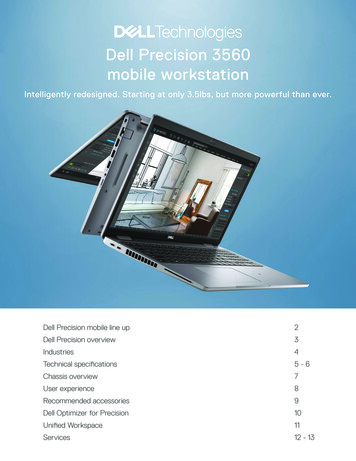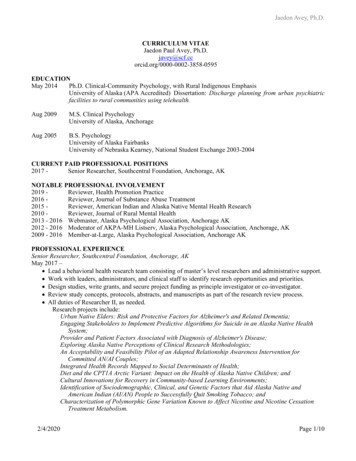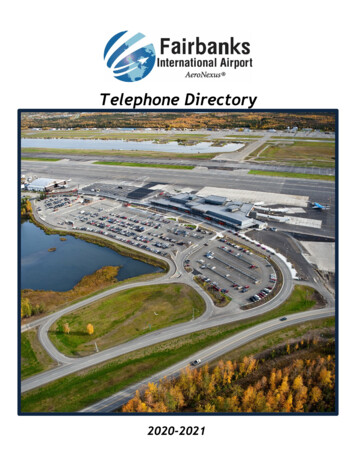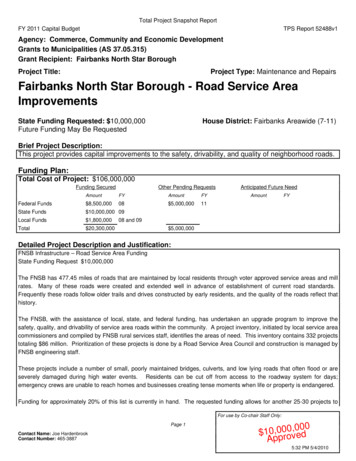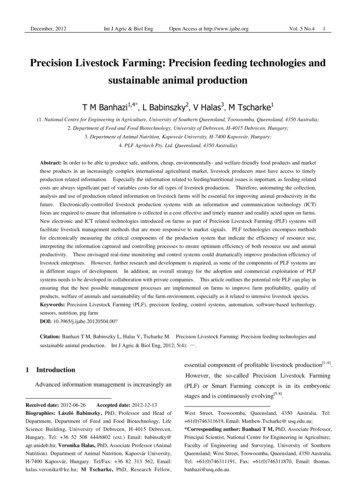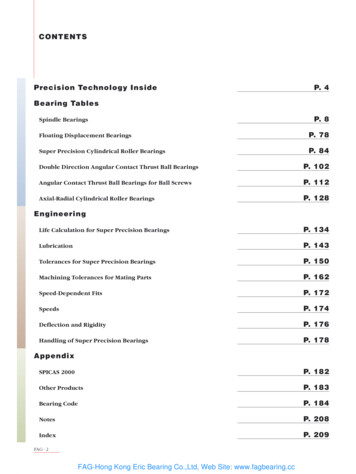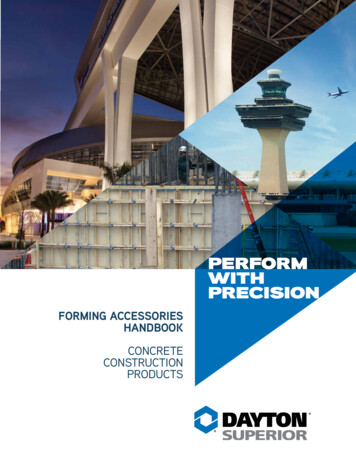
Transcription
PERFORMWITHPRECISIONFORMING ACCESSORIESHANDBOOKCONCRETECONSTRUCTIONPRODUCTS
REAL-WORLD SOLUTIONSINSPIRED BY YOUR VISIONINNOVATIONCENTERYour vision is to take concrete construction to new heights.We turn that vision into real-world solutions throughprecision research and development, testing and technology.Together we are redefining what is possible in theconcrete construction industry. Our Innovation Centeris comprised of: A state of the art chemical labA full-featured mechanical test facilityProduct demonstration areasContemporary training and meeting areasBring us your ideas and we will deliver your solution.Call today: 888-977-9600Perform with Precision
A2 Plastic Cones.19A3 Standard Snap Tie.19A3 Heavy Snap Tie.20A4H Hex Head Snap Tie.20How to Break Back A4 Snap Ties.21A5 Threaded PullOut Tie.21A6 Spandrel Point Tie.21A7 Spandrel Hook Tie.22A7A Spandrel Plate Tie.22A9 / A9H Tip-To-Tip Tie, Standard and Heavy.22A10 Plate Tie. 23A13 Metal Strapping. 23A16 Omni Wedge. 23A16SB Snap Bracket. 23A18 Panel Bolt. 23A19 Corner Washer. 24A21 Strap Ties And Accessories. 24A21X Flat Tie. 25A22 Spreader Cleats . 26A27 and A27-M Turnbuckle Form Aligners . 27A28 Adjustable Kicker. 27A29 Snap Tie Wrench. 28A31 Wrench Head Snap Tie Socket. 28A40 Cone Removal Wrench. 28A43 Footing Tie. 28A44 Stainless Steel Snap Tie. 29A45 Base Tie. 29A46 Loop Panel Tie, Standard and Heavy. 29A48 Gang Loop Tie, Standard and Heavy. 30A51 Wedge Bolt. 30A52 Z Tie Holder and A53 Waler Tie. 30A54 Snaplug .31A55 Sure-Lock Tie, A56 Sure-Lock Bracket, .31A57 Sure-Lock Strongback Bracket, .31A63 Strongback Loop Tie. 32A81 Jahn “A” Bracket. 32A82 Jahn “C” Bracket. 33A83 Jahn Cornerlock. 33A89 Jahn Scaffold Jack. 34How to Use the Jahn Forming System. 35Using Single Vertical Wales for Curved Walls. 42Column and Pilaster Forming Suggestions. 42A90 Scaffold Bracket Jack. 43A93C Sure Guard Rail Post System. 44A97 4x4 Post Shore Clamp. 44A100 Speed Step Bracket. 45A110 Dayton Superior Metal Rib. 4512/15General Slabwork.77C1B and C1C Wedge Hangers.77C2 Coil Hanger Saddle Type. 78C3 Coil Half Hanger. 79C13 Plate Saddle Hanger. 79C13A All-Wire Saddle Hanger.80C14 Channel Hanger.81Methods of Screeding. 82G1 Pipe Holder. 83G1U Special U-Shaped Cradle Head. 83G2 Screed Chair Bases. 83G2J Joist Type Adjustable Screed Base. 83G2S Special Height Screed Base. 84G3 Screed Chair Base With Sand Plate. 84G4 and G4A Screed Bases, Drive Type. 84G5 Screed Bases, Free Fit Type. 85G7 Screed Chair Base for Steel Deck. 85G8 Form Bracket. 85G11 Screed Stake for Pipe. 86G14 Heavy Duty Screed Holders. 86G15 Heavy Duty Screed Support. 86G16 Heavy Duty Screed Chair Base. 87G27 Round Stake. 87G28 and G29 Screed Bracket. 87G33 Screed Key Joint. 88G34 Load Key Joint. 88G35 Plastic Cap Strip. 88G37 Stake. 88How to Use Screed Key Joint. 89Proper Method for Installing Load Key Joint.91G60 Curb Smart. 93Curb Smart Installation. 94Supports for Rebar and Wire Mesh. 95Miscellaneous.99Formliner Materials. 99F56, F57, F58, F59, F60, F61 Expanded CoilInserts. 100F42 Loop Ferrule Insert. 100F44 Thin Slab Ferrule Insert. 100F7, F7L Shelf Angle Insert . 100F54 Ductile Embed. 100F54C Nylon Rail Track Insert. 100Index.102General and Technical InformationB1 Two Strut Coil Tie and B2 Four Strut Coil Tie. 47B1B3 and B2B3 Screw-On Coil Tie. 48Coils. 49B6 Welding Coil Tie. 49B7 and B22 Inserts (Crimp). 49B11 Flat Washers. 50B12 Coil Rod. 50B12A D/R Thread Bar.51B13 Coil Nut and B25 Heavy Coil Nut. 52B14 Coil Bolts. 52B14A Adjustable Coil Bolt. 53B14W Wale Bolt Assembly. 54B15 Plastic Cone Removal Wrench. 54B16 Coil Loop Insert Straight. 54B17 Double Flared Coil Loop Insert. 55B18 Single Flared Coil Insert. 55B20 Wale Holder. 56B21 Plylag. 56B27 and D6 Nut Washer. 57B29 Loose Plastic Cone. 57B30 Screw-On Plastic Cones. 58B31 Rock Anchor. 58B32 Handle Coil Nut. 59B33 Double Flared Criss Cross Coil Loop Insert.59B37 Toggle Tie. 60B39 Wing Nut. 60B40 Plastic Setback Plug.61B42 and D22 Batter Washer.61B43 Triple Flared Coil Loop Insert.61D1 and D18 Inside Tie Rods. 62D1-J, D1LA and D1L Hook Bolts. 63D1S Anchor Bolt Sleeve. 63D2 and D30 She-Bolts. 64D4 Hex Coupling Nut. 65D9 Taper Ties. 65D9A D/R Thread Bar Taper Tie. 66D12 Rod Clamps. 66D12A Pencil Rod. 67D12F Form Clamp. 67D14 Tightening Wrench. 67D21 Rebar Clip and Form Spreader. 68D24 Weld Angle Bracket. 68D25 Fitting Up Bolt and D26 Fitting Up Nut. 69D27 Lag Bolt. 69D30A D/R Thread Bar She-Bolt. 70D32 Closed Coupler. 70D33 Water Resistant Washer. 70D40 He-Bolts. 71Typical He-Bolt Anchors. 72Special He-Bolt Inserts. 72D42 Bag Ties. 72PC110 Impalement Safety Cap.73D46 Tie Wire.73D48 Sure-Guard Rebar Protective Cap.73A58 Sure Plug.74A59 Insertion Tool.74F1 Screw Anchor and F2 Screw Anchor Bolt. 75Light Forming ProductsLight Forming. 19Medium/Heavy Forming.47Medium/Heavy Forming ProductsDefinitions. 1Safety Notes and Product Application. 1Dayton Superior Technical Services . 1Usage Affecting a Product’s Safe Working Load.2Induced Tension Loads. 6Induced Shear Loads. 6Combined Shear and Tension Loads. 6Forming Accessories Selection.7Load Carrying Capacity Classifications:.7Method of Use Classifications:.7Lumber and Form Tie Analysis.7Calculations for Formwork Costs. 8Determining Required Quantities of Form Ties. 8Typical Formwork Designs for Wall Forms. 9Vertical Formwork Design Loads.10Slab Formwork Design Loads.11Technical Data–Plywood.12Technical Data–Lumber.13Flat Slab Forming ProductsGeneral and Technical Information. 1MiscellaneousTable of Contents
General and Technical InformationAbout Dayton SuperiorDayton Superior’s reputation as the industry leaderin the design, manufacturing and distribution ofspecialized concrete construction products is theresult of innovation backed by more than 100 yearsof experience. Proven concrete solutions that spana wide breadth of industry disciplines and the mostcomprehensive product offering in concrete construction makes Dayton Superior the preferred partner fordistributors, contractors, architects and engineers.Light Forming ProductsDayton Superior’s products are found on virtuallyevery major construction site in North Americaincluding: Local roadways, national highways, runways andbridges High-profile urban high-rises and suburban mixeduse structures Water treatment and government service facilities,education and healthcare institutions Entertainment venues, retail and restaurantprojectsAccessoriesMedium/Heavy Forming ProductsWith an unwavering commitment to continuous improvement, Dayton Superior employs creativity and disciplineto develop timely and innovative solutions that add valuefor customers and distributors through:ChemicalsFlat Slab Forming ProductsForming The largest, most experienced engineering andsales team in the industry Access to a wealth of detailed technical informationvia the Dayton Superior website coupled witha highly skilled team of technical serviceprofessionals A team of 70 customer service advisorsproviding responsive customer care along withDayton Access , a 24/7 web-based tool providingorder status information A nationwide distribution network of over 2,700dealer distributor locations and 14 strategicallylocated, company-owned distribution centers An unmatched track record of product innovationand industry leadershipIn the concrete construction industry, Dayton Superior’sreputation for quality, service and support is unequalled.MiscellaneousPaving12/15
DefinitionsSafe Working Load — The maximum working load that should be applied to any forming product.Ultimate Load — The load at which a product fails or will no longer support or carry a load.Safety Factor — The theoretical reserve capability defined by dividing the ultimate load of the product byits safe working load. This is expressed as a ratio, such as 2:1 or 2 to 1 (ultimate to safeworking load).Concrete Form Pressure — The lateral pressure applied per square foot of form contact.Slab Formwork Dead Load — The weight of fresh concrete and reinforcement bars plus the weight of the formwork.Slab Formwork Live Load — Any additional loads imposed during the construction process, such as materials, workmen,equipment, including lateral forces.Slab Formwork Design Load — Dead load plus live load per square foot of contact.Formwork Impact Load — Loads caused by dumping concrete or the starting/stopping of construction related equipment.Safety Notes and Product ApplicationDayton Superior ensures that all products meet or exceed appropriate safety requirements. However, the performance of a productcan be greatly affected by the manner in which it is used. It is imperative that the user properly installs and uses the products displayed in this publication.Production runs are constantly tested to assure a high standard of quality. Safe working loads listed in this publication were determined from independent testing and results of the Company quality assurance/quality control program.Safety factors may be dependent on the application of a particular product. Job site conditions can often affect the safety factor ofa product. Concentrated loads, such as, unsymmetrical loading, uplift, impact and lateral forces are examples of job site conditionsthat may affect the safety factor. The user must adjust safety factors accordingly to accommodate these various conditions.Dayton Superior publishes the minimum safe working loads and the associated safety factors of its products and strongly advisesthat the minimum safety factors displayed in the table below not be compromised. When there are unusual job conditions suchas mentioned above, the minimum safety factors must be increased by the user. Refer to the provisions of the American NationalStandards Institute (ANSI A 10.9), the Occupational Safety and Health Administration (OSHA) Act, Part 1910 and the AmericanConcrete Institute (ACI) Recommended Practice for Concrete Formwork (ACI 347-94) when considering product safety factors.Minimum Safety Factors of Formwork AccessoriesAccessorySafety FactorType of ConstructionForm Tie2.0 to 1All applications.Form Anchor2.0 to 1Formwork supporting form weight and concrete pressures only.Form Anchor3.0 to 1Formwork supporting form weight, concrete, construction liveloads and impact.Form Hangers2.0 to 1All applications.Anchoring Inserts (Used as Form Ties)2.0 to 1Precast concrete panels when used as formwork.Dayton Superior Technical ServicesDayton Superior maintains three strategically located technical departments that are well staffed with trained personnel to serviceinquiries concerning Dayton Superior products and/or methods.12/151General and Technical InformationGeneral and Technical Information
General and Technical InformationGeneral and Technical InformationUsage Affecting a Product’s Safe Working LoadForming accessories may be subjected to excessive wear, field modification/bending and straightening. Any product sonoted must be discarded. Do not try to straighten bent forming accessories; discard and replace them. Also discard anyreusable device that has experienced excessive loading, 70% or more, of ultimate load. Such items may have become brittle.Every user must establish a control program that replaces reusable forming products after a predetermined time period or numberof uses, regardless of product appearance. All reusable forming accessories shown in this publication are subject to wear, misuse,overloading, corrosion, deformation, intentional alteration and other factors which may affect the product’s safe working load.Therefore, it is mandatory that the user inspect all reusable accessories to determine their condition. The frequency of inspection isdependent on factors such as frequency of use, period of use, environment, etc., and is best determined by the user consistent withgood construction practices.When in doubt about the proper use or installation of Dayton Superior forming accessories, contact Dayton Superior for clarification. Failure to do so may result in exposure of workers to safety hazards, resulting in possible injury and/or death.All safe working loads shown in this publication contain an approximate minimum safety factor. The safe working loads wereestablished with the following factors in mind:1.All safe working loads are based on the accessory being in new or in “as new” condition. The safe working load is consideredto be the maximum load that should be applied to a product.2.The safe working load of Dayton Superior Snap Ties and related products can only be developed when used in conjunctionwith A16 Omni Wedges, A81 Jahn A Brackets or A82 Jahn C Brackets.3.Care is taken to ensure that internal vibration has not caused snap tie wedges to loosen, bounce around or fall off.DoubleHeadDouble HeadNailsNailsWedge LoosensLoosens andOffOffWedgeandBouncesBouncesRight4.WrongIt is important that the snap tie head and wedge be positioned properly.The proper tie head position is at the midpoint, or higher, of the wedge slot. The tie head must not be positioned lower thanthe midpoint of the wedge.Snap Tie HeadSnap Tie HeadRight2Wrong12/15
5.When using snap ties, correct spacing between double wales is 5/8" to 3/4".BreakBackBreakbackCorrectis 5/8"5/8"toto3/4"3/4"Correct SpacingSpacing rorSpreader WasherorConeConeEmbeddedEmbeddedinConcretein ConcreteWrongToo much space allowed between the wales may cause crushing of the wales and/or the bending of the wedge allowing theform to bulge outward. This results in incorrect wall thickness and causes the tie spreader washers or cones to becomeembedded and trapped in the concrete. Trapped tie washers or cones will cause difficulties during the tie breakback operation.6.The plastic tie cones and metal washers are designed to act as form spreaders only.MidpointMidpoint ofWedgeWedgeMetalMetal cWillShatterWill ShatterWrongDo not attempt to draw-up warped wales with the wedge. Do not over tighten the wedge in any manner. Over tightening will causemetal spreader washers to bend out of shape or will break plastic cones resulting in incorrect wall thickness.7.Care must be taken to be sure that all form ties are installed and used properly.TieTieHasHasBeenBeenLeftLeft OutOutRightWrongFailure to install all of the required ties or their required mating hardware will cause excessive loads to be transferred to adjacent ties and may result in form failure.12/153General and Technical InformationGeneral and Technical Information
General and Technical InformationGeneral and Technical InformationCare must be taken to ensure that form ties are properly aligned. Misalignment may result in form failure due to increased loadsplaced on the form ties. Misalignment may also cause damage to the form tie during installation that may result in reduced loadcapacities.Right8.WrongWhen using coil bolts, coil ties, coil hanger saddles, he-bolts, taper-ties, she-bolts and other coil thread items, maximumspacing between the double wales should be 1/2" more than the nominal diameter of the bolting device being used.When too much space is allowed between the wales, the wales may crush or the washers may bend. This causes theBolt Dia. dCone Embeddedinin ConcreteConcreteCrushingCrushing ofWalesof WalesWrongform to move outward to cause incorrect wall thickness and allowing the spreader cones to become trapped in the concrete. The higher than anticipated lateral form pressure can also deflect the washers resulting in incorrect wall thickness.412/15
9.Coil bolts, coil rod and other coil thread products must have proper coil penetration. A bolting device with proper coil penetration will extend past the coil a minimum of one diameter of the bolting device. For example, a properly penetrating 1/2" diameter coil bolt will extend past the coil a minimum of 1/2". Incorrect penetration of threaded items may result in form failure.Failure to obtain proper penetration will cause excessive wear on the first few threads of the bolt, but more importantly itBolt DiameterMinimum CoilPenetrationSeeChartTable forforSee1/2"2"Minimum InsufficientCoil PenetrationForm FailureWrongplaces the entire bolt load on a smaller portion of the coil welds. The increased loading can cause the coil welds to fail andresult in form failure.10. Do not beat on the end of loop ties to force them into position. This may damage the tie and result in form failure.11.Use only correct length form ties. Incorrect length ties, when mixed with correct ones, will cause a transfer of lateral pressureto adjacent ties and may result in form failure.12. Do not climb on form ties.13. Do not use impact wrenches to tighten form-tying devices.14. Do not over-vibrate the concrete. Excessive vibration will cause concrete at the bottom of the form to remain in a liquid statelonger than expected. This will result in higher than anticipated lateral form pressure and may result in a form failure. Depthof vibration should be limited to within four (4) feet of the top of the fresh uidConcreteLiquid ConcreteFullHeightHeightofoftheFullthe FormFormConcrete hasConcrete ateralPressureReduceLateralis ReducedPressure12/155General and Technical InformationGeneral and Technical Information
General and Technical InformationGeneral and Technical Information15. Do not exceed the recommended rate of placement and do not continue to place concrete while the concrete in the bottom ofthe form is still in a liquid state. A form failure may result.16. Do not use forming accessories with underrated workingparts.17. All forming accessories and related hardware must be ofproper length, diameter and capacity. If a greater safetyfactor is necessary for any reason, the user must reduce thesafe working load accordingly.18. Extreme caution must be used when welding any formingsystem item. Welding may affect material properties resulting in lower product performance. It is necessary to havea good working knowledge of materials, heat treating andwelding procedures before welding any forming accessory. Since Dayton Superior cannot control field conditionsor workmanship, Dayton Superior does not guarantee anyproduct altered in any way after leaving the ementRecommendedRecommendedRateRateof ofPlacementPlacementInduced Tension LoadsIt is important to remember that tying at an angle causes an increase in the tension that is applied to the angled tie. The table listsvarious angles and the corresponding multiplication factor to use in calculating the tensionload in an angled tie.AngleMultiplication Factor15 1.0430 1.1645 1.4260 2.00AngleAnglePressurePressureTeTennssioionnNote: Tension Pressure x Multiplication FactorInduced Shear LoadsBoth tension and shear loads must be taken into consideration when deciding which form tie system to be usedfor a particular forming application.TieDownDown LoadLoad Shear.71.71xxTieShearLoadLoadx TieDownDownLoadLoad Shear.50.50x TieShearLoadLoad45 30 .26.26x TieShearLoadLoadx tieDownDownLoadLoad Shear15 aaddLoonn LowwDDoeieTiTnniosionesnTeTIt is important to remember that tie downs placed atan angle will produce shear loads as shown. Thetotal shear load may be several times greater than theshear load produced by the weight of the form alone.TotalShearLoadLoadTotal ShearCombined Shear and Tension LoadsForm accessories and inserts that are subjected to combined shear and tension loading should satisfy the following equation:(ft /Ft)5/3 (fv /Fv)5/3 1.06Whereft induced tension load,Ft insert tension safe working load or bolt tension safe working load, whichever is less,fv induced shear load,Fv insert shear safe working load or bolt shear safe working load, whichever is less.12/15
Forming Accessories SelectionDayton Superior Concrete Accessories manufactures and supplies a large variety of form tying devices for concrete formwork.Form tying devices can generally be classified in two ways, by load carrying capacity and by method of use.Load Carrying Capacity Classifications:Light Forming — Light forming form ties have safe working load values of 3,750 pounds or less. Typical lightduty ties include Snap Ties, Loop Ties and Pencil Rod.Medium/Heavy Forming — Medium/heavy form ties have safe working load values over 3,750 pounds. Typicalmedium/heavy form ties include Coil Ties, She-Bolts, Taper Ties, etc.Method of Use Classifications:Through Ties — This type of tie extends through the wall thickness and through both sides of the formwork.Dayton Superior manufactures four types of through ties to satisfy most forming applicationrequirements. Snap Ties, Loop Ties, Taper Ties and Pencil Rod are all quality through tiesystems.Coil Ties — The Coil Tie System consists of two Coil Bolts, two Flat Washers, optional Tie Cones and aCoil Tie. The optional Tie Cones act as an internal spreader and assures proper set-back ofthe tie. Continuous Threaded Coil Rod can be used in place of the Coil Bolts in emergencyconditions or in applications requiring varying bolt lengths.She-Bolts — A She-Bolt has external threads on the large end and internal threads on the tapered end.The external threads provide adjustment for varying form thickness. The internal threadsprovide attachment for the Inside Rod that ties the two She-Bolt sections together. Variousworking parts and form anchorages, are available for use with the She-Bolt System.Lumber and Form Tie AnalysisAssume a project contains 100,000 square feet of form contact area. 12" thick walls x 14'-0" high and that 10,000 square feet ofform will be constructed. Schedule will be six months with form reuse based on three uses per month.Assume that the working parts are purchased. Experience has shown that Example A working parts have a life of 10 uses andExample B working parts have a life of 50 uses. Form lumber in Example A has a salvage value of 25% while Example B has asalvage value of 60%.For this analysis the cost of nails, band iron, connecting bolts, lifting devices, etc., have been omitted. Both examples were calculated in the same manner with the exception of the number ofExample AExample Buses of the working parts and the difference in salvage value3/4" Plywood3/4" Plywoodas noted.2"x4" Studs @ 12" o.c.2"x4" Studs @ 6" o.c.2–2"x4" Wales @ 24" o.c.2–3"x6" Wales @ 24" o.c.A3, A4 or A44 StandardB1 Heavy Coil Ties @ 32" o.c.Snap Ties @ 24" o.c.D1 or D18 Inside Rod with SheBolts @ 32" o.c.Rate of Placement:Rate of Placement:50 F. 2-1/4 ft./hr.50 F. 10 ft./hr.70 F. 3-1/4 ft./hr.70 F. 10 ft./hr.The two examples present average costs for lumber and formties. The examples are only displayed to give the reader anoutline to prepare similar cost analyses for specific formworkdesigns. Note that labor costs must be added to the materialcosts. Example A has 12,500 ties that must be installed andremoved and 25,000 tie holes to be patched. Ex
Accessory Safety Factor Type of Construction Form Tie 2.0 to 1 All applications. Form Anchor 2.0 to 1 Formwork supporting form weight and concrete pressures only. Form Anchor 3.0 to 1 Formwork supporting form weight, concrete, construction live
